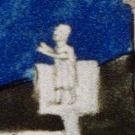
This page created 23 March 2014, and last modified: 23 September 2015 (standard section added)

The Quinta Macedonica is listed (15.16 in Ingo Maier's numbering scheme) as the first of the nine legiones comitatenses under the Magister Militum per Orientem. Its shield pattern (13#4), as shown in various manuscripts under the matching label (13.d) Quinta Macedonica, is as below:

The pattern shows a blue boss (white in B) with a yellow rim and an indigo centre (absent in M, B). The main field is white, with a red rim. Surrounding the boss is what appears to be a maroon six-petalled flower (red in B) with thorns projecting from the petal junctions; in W, these thorns are coloured blue. The shield pattern bears a certain stylistic resemblance to that of the Tertia Diocletiana Thebaeorum under (18.15) the Magister Militum per Thracias, as can be seen below from the following patterns taken from the Paris manuscript:

Perhaps these two detachments were posted simultaneously to the same command and thus received similar shield patterns, but were later separated. Given the Legio quinta Macadonica, stationed at Memfi (52.2) under the Comes limitis Aegypti, and the Legio tertia Diocletiana stationed (56/7.10) at Ambos under the Dux Thebaidos, an initial posting after leaving Egypt seems likely in this case, i.e. when they arrived in Macedonia after Theodosius' great Egyptian unit redeployment. In the case of Legio quinta Macedonica, this would actually most likely be back in Macedonia, given the four detachments commanded by prefects under the Dux Daciae ripensis, under the multiple entries Praefectus legionis quintae Macedonicae, and stationed at Variniana, Cebro, Oesco, and Sucidava (80.20-22,28). These are all clearly descended from the old Legio V Macedonica raised by Octavian in 43 BC, and long headquartered at Oescus (modern Gigen in Bulgaria). Inscriptional evidence for Legio V Macaedonica extends as far as 635 in Egypt (the Arabs conquered the province in 637), and it is just possible the Dacian contingent lasted even longer, albeit unattested.
A papyrus (ChLA XLV 1328 (399)) mentioning the Egyptian detachment receiving 835 annonae diurnae has been interpreted as implying the detachment had a strength of 750 - 800 men, allowing for officers having multiple shares (see Amin Benaissa, ZPE 175 (2010) 224-226, available here), possibly representing two old-style cohorts' worth of men. If the Oriental field army detachment was of similar size, then the four detachments remaining under the Dux Daciae ripensis would presumably have been smaller, or the various detachments would together total well over 10 cohorts' worth of men.
Interestingly, an image of the Memfi detachment's standard may have survived: the frontpiece for the Comes limitis Aegypti uniquely illustrates what may well be standards of some of the Egyptian units arising out of their station depictions. Nine such decorated poles are shown: two are clearly of the aquila (Eagle)-type, five are of the imago (Imperial portrait)-type, one's shape is hard to discern, and one is a globus cruciger (orb surmounted by a cross). That shown in Memfi, and thus presumably belonging to Legio quinta Mac[e]donica, is of the imago-type, with a single figure apparently surmounting a crudely-drawn vexillum (flag suspended from a cross-bar), as can be seen from the close-up of the image shown below from the Bodleian manuscript (O):

The size of the illustration means details of the figure, and thus its identity, are impossible to discern. It is possible other detachments of the legion carried similar standards.

Return to the Notitia alphabetical unit list page.
Return to my Notitia index page.